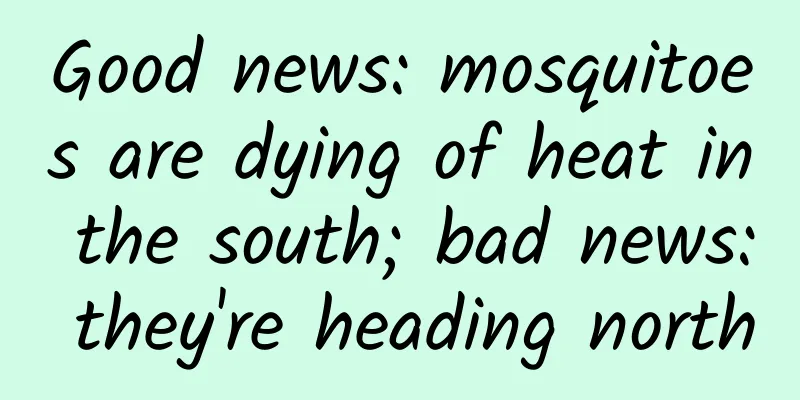Good news: mosquitoes are dying of heat in the south; bad news: they're heading north

|
August 20th is World Mosquito Day . This day is not to commemorate the most murderous animals such as mosquitoes, but to commemorate the British doctor Sir Ronald Ross who discovered in 1879 that female mosquitoes can transmit malaria between humans. In other words, this day is to raise people's awareness of mosquito-borne diseases. Everyone hates mosquitoes, and they are always there in every summer. However, this year seems a little unusual - summer is almost over, and many friends in the south have not seen the same large number of mosquitoes as in previous years , and even the prepared mosquito coils have not come in handy. What happened this summer? Are there really fewer mosquitoes? Are they also killed by the high temperatures and don't want to be in business anymore? Is the absence of mosquitoes a good thing for us? The mystery of the disappearing mosquitoes It is true that mosquitoes have disappeared, but it is very likely that it is not the mosquitoes themselves that died of the heat, but their children . Aedes aegypti | James Gathany / Wikimedia Commons The development of mosquito eggs and larvae is directly related to temperature . Mosquito larvae usually live in places with stagnant water, such as ponds and ditches. They often float upside down with their tails close to the water surface, and use the breathing tube near the tail end of the abdomen to directly breathe the air on the water surface. Taking the Aedes aegypti mosquito, which is widely distributed around the world (including southern China), as an example, experiments have found that when the water temperature is around 26°C, the survival rate of Aedes aegypti larvae is the highest, reaching 90.5%. When the water temperature is below 16°C or above 38°C, their survival rate will be greatly reduced, and they will all die when the water temperature reaches 40°C . At the pupal stage, if the temperature reaches 38°C, most pupae will become "stillborn", and only 11% of pupae can become adults. Even if they survive by chance, the final adult will become small, weak, and not very active. Mosquito larvae | ProjectManhattan / Wikimedia Commons The temperature of the juvenile stage will also affect the size and reproductive capacity of mosquitoes when they grow up. Mosquitoes that grow up in a lower water temperature environment will be larger as adults. The larger the mosquito, the higher its reproductive capacity. The mosquitoes that grew up in the high temperature this year are all small mosquitoes with low reproductive capacity. In order to survive, mosquitoes can only work hard to find hosts and suck more blood to enhance their reproductive capacity, so we feel that mosquitoes prefer to bite people | James Gathany, USCDCP / Wikimedia Commons Temperature also determines how active adult mosquitoes are. Aedes aegypti can fly in a temperature range of 15 to 32°C, and the most suitable temperature for their activity is 21°C. Above 35°C, mosquitoes rarely reproduce. This summer, the temperature in many areas of southern China once climbed to over 40°C, which is a deadly high temperature for mosquitoes. People know that if you hide in an air-conditioned room, mosquitoes will fly to the shade and wait until the sun sets and the temperature drops before coming out. The peak blood-sucking period for the common domestic Culex pipiens and Culex tritaeniorhynchus is in the early morning and evening . Some friends avoid the scorching sun during the day and go out for a walk at night, which may happen to be a chance encounter with mosquitoes that are out for business. Mosquito: Here comes my dinner | Shura F / Wikimedia Commons In many places, the high temperature has lasted for two or three months. The adult mosquitoes are too hot to move and reproduce, and the juvenile mosquitoes cannot survive the heat, so people naturally think that there are fewer mosquitoes. In some areas with high temperatures and little precipitation, the stagnant water and wetlands have evaporated, so mosquitoes can't find a place to lay eggs even if they want to, and their numbers are even smaller. The disappearance of mosquitoes in the south is not a good thing Great! The mosquitoes are dying of heat! Don’t be too happy yet. The south is getting hotter, but mosquitoes won’t just sit there and wait for death. Their solution is to head north to escape the heat . There are more than 3,600 species and subspecies of mosquitoes discovered in the world, and more than 370 species are found in China, including Aedes aegypti, Aedes albopictus, Anopheles anthropophagus, Culex pipiens, etc. Most of them live in the south. Among them, Aedes albopictus is the famous "flower mosquito", with black and white stripes on its body, which is very aggressive and poisonous. Once it bites a person, it will leave a big bump that will not go away for half a day. They originally lived in Southeast Asian countries and were introduced to China through maritime trade, mainly in Guangdong, Guangxi and Yunnan. As high temperatures swept across the south, more and more people have seen them in the north in recent years. Flower Mosquito himself | James Gathany, CDC / Wikimedia Commons For friends in the north, the mosquitoes moving north is not good news, it means that the fierce and biting mosquitoes common in the south can also be seen in the north, and with them come the diseases they carry. There are three main types of mosquitoes that spread diseases: Culex, Aedes and Anopheles , and the diseases they spread include malaria, filariasis, yellow fever, dengue fever and Zika virus . Malaria rapid diagnostic test | USAID / Wikimedia Commons Mosquitoes are moving northward, and it's not just our country that is affected. In the coming decades, changes in the range of mosquitoes will put countless people around the world at risk of contracting mosquito-borne diseases . More importantly, these diseases, which were previously strictly tropical diseases, are now spreading to high latitudes, such as Canada and northern Europe. These diseases have not spread to high latitudes before, so they are more likely to become large-scale epidemics in the population. A 2021 study suggests that by 2070, up to 4.7 billion more people could be at risk of malaria and dengue fever than between 1970 and 1999, and that these mosquito-borne diseases will reappear in places where they had disappeared. The World Health Organization estimates that even with continued improvements in economic conditions and public health, climate change could cause an additional 60,000 deaths from malaria between 2030 and 2050. If non-fatal mosquito-borne diseases are taken into account, even more people will be affected by chronic diseases. Other insects are miserable too. When annoying mosquitoes die due to high temperatures, we may not only not feel sorry, but also want to applaud. However, it is not only mosquitoes that suffer in hot weather , but also many other insects, such as bees that are beneficial to humans. A drone bee dies from ejaculation due to high temperature stress, with its genitals exposed | Emily Huxter During the months of high temperatures, many European countries have observed the continuous death of bees , and most of the dead are male bees, whose genitals are exposed when they die. Male bees are very sensitive to temperature, and under the pressure of high temperature, the natural reaction of male bees is to ejaculate and then die. At 42°C, 50% of male bees will die within 6 hours , but only after being exposed to 42°C for 2 hours, one-third of the sperm ejaculated by the male bees will die. Even if the male bees survive the high temperature, their fertility will be damaged. The only queen bee in a colony, laying eggs, in the center | Piscisgate / Wikimedia Commons Under high temperatures, queen bees have a stronger ability to survive than male bees, and they can stay in an environment above 38 degrees Celsius for more than 2 hours. The queen bee has a spermatheca in its body, which can store sperm for 1 to 3 years during mating. Although the queen bee can barely survive in a heat wave, the quality of the sperm stored in its body will be greatly reduced. Many plants rely on bees for pollination | Alison McAfee The damage caused by high temperatures is accompanied by a chain reaction. When the heat wave is over, the queen bee will have no high-quality sperm and fewer opportunities to mate, which may lead to the collapse of the entire bee colony . Plants that rely on bees for pollination will also suffer , including many crops that humans rely on for survival. Beekeepers may have to import new queen bees from other places to increase the genetic diversity of the bee colony and allow them to adapt to higher temperatures. In addition to bees, high temperatures can also affect the reproductive ability of insects such as bumblebees, wasps, beetles and moths. Male red flour beetles (Tribolium castaneum) who have been exposed to high temperatures have reduced fertility in their sons, even if the sons themselves have not experienced high temperatures. Scientists have also found that the chance of seeing bumblebees in specific locations in North America has decreased by 46% compared to the last century, and some bumblebee species may face local extinction under continued high temperatures. The dwindling number of bumblebees. Large and furry, they were originally adapted to cooler environments, such as temperate and polar regions | Antoine Morin Mosquitoes can only survive for one or two months and are replaced very quickly, which helps them adapt to climate change (and perhaps mosquitoes will be more heat-resistant in the future). However, the reproduction cycle of insects such as bees is measured in years. The rapid environmental changes make it impossible for them to adapt in time, and they may go on the road to extinction. Mosquitoes have disappeared because of the hot weather, but this is just nature's warning to humans - the consequences of rising temperatures year after year will one day affect humans themselves. References [1]https://www.frontiersin.org/articles/10.3389/fmicb.2020.584846/full [2]https://www.sciencedirect.com/science/article/abs/pii/0022191068900188?via%3Dihub [3] https://journals.plos.org/plosone/article?id=10.1371/journal.pone.0058824 [4]https://academic.oup.com/jme/article/50/4/838/890791 [5]www.cnki.com.cn/Article/CJFDTotal-ZMSK199701024.htm [6]http://www.bmsw.net.cn/CN/abstract/abstract14048.shtml [7] https://www.lowyinstitute.org/the-interpreter/what-climate-change-means-mosquito-borne-diseases [8] https://elifesciences.org/articles/69630 [9]https://news.ufl.edu/2019/03/mosquito-borne-illness/ [10] https://www.nature.com/articles/s42003-022-03092-7 [11]https://theconversation.com/extreme-heat-waves-threaten-honeybee-fertility-and-trigger-sudden-death-178504 [12]https://www.cbc.ca/news/science/bumble-bee-heat-waves-1.5453156 Author: Cat Tun Edit: Flip This article is authorized to be reproduced from Guokr (ID: Guokr42) If you need to reprint, please contact [email protected] Welcome to forward to your circle of friends |
<<: It turns out that physicists really eat Chinese food every Friday! Sheldon is not lying to me
>>: Will taking a nap make you stupid?
Recommend
How to operate with millions of users?
Whether it is a website or an APP, when the numbe...
Apple Store app has been revamped: new shopping sync feature added
Just as Apple is about to hold a new product laun...
Strategies for creating popular articles on Xiaohongshu!
01 About the hot articles on Xiaohongshu 1) For a...
How much does it cost to develop a kitchen app in Changji?
How much does it cost to develop a Changji cateri...
Many Internet celebrity food stores have "turned over", these 5 types of food are very dangerous after spoiling
Key Points ★ Even if part of the fruit is rotten,...
Salute to Teacher's Day | With high-tech equipment entering the classroom, teachers are becoming more and more fashionable!
Today is Teacher's Day. When you think back t...
Touching China丨He leads the country's electric vehicles to gallop and overtake on the new energy track!
Twenty-one years later, our original intention ha...
Anqing SEO Training: Do visitor preferences affect visit rate? How does SEO grasp visitor preferences?
A good website is undoubtedly the hard work of ma...
What should be the bandwidth of an average server?
What should be the bandwidth of an ordinary serve...
The train to Shangri-La is coming! The Lixiang section of the Yunnan-Tibet Railway is about to open. What are the "check-in points" along the way?
It is reported that the Lijiang-Xiangjiang sectio...
A comprehensive inventory of model hard-working animals, dung beetles are on the list?
Today is the third day of the May Day holiday. Wh...
10,000-word analysis: How the top 10 platforms use red envelopes to increase user growth during the 2020 Spring Festival
Every Spring Festival, the red envelope strategy ...
Huawei's 5G phones are back, but supply may be limited
The Kirin 9000 chip used in the P50 Pro previousl...
Is pomegranate a "Chinese magical fruit" that can improve beauty and fight cancer? Nutrition experts: It is not recommended for this type of people to eat too much
There are so many seasonal fruits in autumn, but ...
Information flow advertising delivery is unstable, how to optimize it?
Written in front In response to recent feedback fr...









